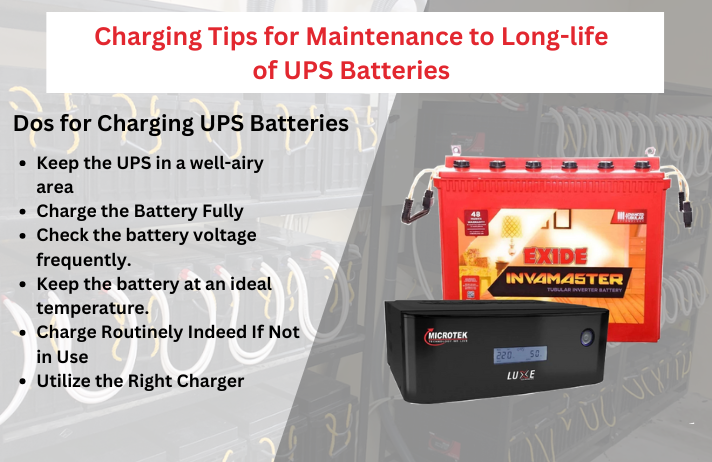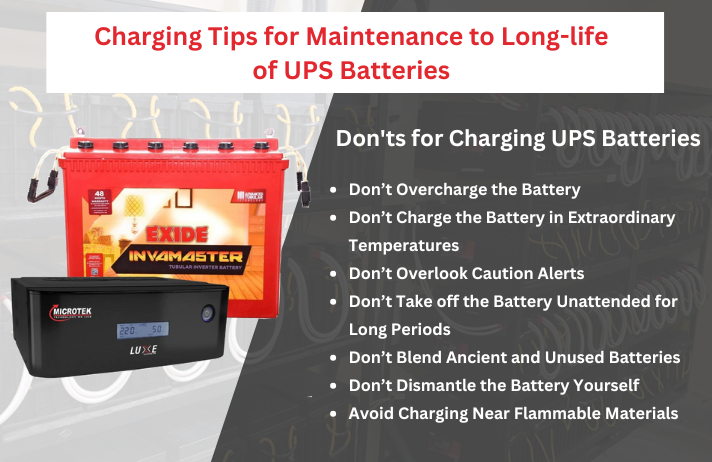Practices For Charging Your UPS Battery Safely & Efficiently
The battery is the heart of a UPS (Uninterruptible Power Supply), ensuring your devices stay powered during outages. Proper battery care is essential for its longevity and efficiency. Neglecting it can lead to reduced performance or complete failure. In this blog, we’ll explore the basic do’s and don’ts for charging UPS batteries, helping you maximize your system's performance and lifespan.

Dos for Charging UPS Batteries
First, the most crucial thing to do when charging your UPS battery is to take after the manufacturer’s data. The UPS (battery reinforcement) comes with a manual that tells you how to securely and legitimately charge the battery. The battery is made to work in certain ways, and taking after the enlightening will make it beyond any doubt that you do not harm the battery or the UPS. Ceaselessly examined the manual carefully, especially the region around charging the battery.
Keep the UPS in a well-airy area
Batteries can produce gas when they are charged. The battery can get too hot or explode if the gas builds up in a small space. So, when charging a UPS battery, you should put it in a place with good airflow. The ventilation system helps keep the battery cool and prevents bad gases from building up. Also, ensure that the area around the UPS is clear of conditions and that the disc can circulate freely.
Charge the Battery Fully
Batteries require being completely charged to work appropriately. If the battery is, for the most part, charged when you get it, charge it all the way sometime recently, utilizing it for the first time. Completely charging the battery, too, makes a difference. Beyond any doubt, the battery life marker has the right information.
Check the battery voltage frequently.
To keep up the prosperity of your UPS battery, it’s crucial to screen the battery voltage routinely. Various present-day UPS systems come with built-in watching highlights that warn you if the voltage is too high or too low. If you take note of a diminishment in voltage over time, it might be a sign that the battery is wearing out and may require being supplanted. It suggests that checking your battery's voltage can help you know if it's working. The Microtek UPS is a highly sought-after model, especially favored for residential use due to its reliability and efficiency.
Keep the battery at an ideal temperature.
Temperature plays a major part in the life of a UPS battery. Batteries tend to debase quicker in tall temperatures. In a perfect world, your UPS battery ought to be kept in a room where the temperature is between 20°C and 25°C (68°F and 77°F). If the temperature is too high, the battery might overheat, lessening its life expectancy. On the other hand, exceptionally low temperatures can cause the battery to solidify or end up drowsy. For great battery health, keep it at a reliable, comfortable temperature.
Charge Routinely Indeed If Not in Use
Even if your UPS is not regularly used, you should charge the battery regularly. A battery that is cleared out and uncharged for a long period can lose its capacity and effectiveness. If the UPS is not fueling any gadgets, it should be stopped and charged every few months. This guarantees that the battery remains sound and prepared for use when needed.
Utilize the Right Charger
Always utilize the charger that comes with the UPS or a consistent one prescribed by the producer. Utilizing the off-base charger can result in cheating or undercharging, harming the battery. The redress charger will direct the voltage and current to suit the battery’s details, making a difference in expanding life expectancy. If you require a supplant for the charger, get one from a trusted source.

Don'ts for Charging UPS Batteries
Don’t Overcharge the Battery
Overcharging is one of individuals' most common botches when charging UPS batteries. It happens when the battery is cleared out and associated with the charger for as long as it has come to a full charge. Charging can lead to an intemperate warm build-up, harming the battery and diminishing its skill. The UPS stops charging the battery when it is fully charged. But it's still a good idea to unplug the UPS or turn it off when the battery is at 100% charge. This avoids pointless strain on the battery
Don’t Charge the Battery in Extraordinary Temperatures
As specified previously, temperature plays an enormous part in the well-being of your UPS battery. Charging a UPS battery in extraordinary hot or cold temperatures can cause irreparable harm. Don’t charge the battery in coordinated daylight or close warm sources like radiators. Don't charge the battery when it's very cold outside. If the temperature is as high, the battery might solidify, which can abbreviate its life or cause it to fail.
Don’t Overlook Caution Alerts
Many UPS frameworks come with caution alarms to inform you of any issues, such as a low battery, cheating, or a breaking-down battery. These alarms are there for your security and guaranteeing that the UPS works accurately. Overlooking these notices can lead to greater issues down the street. If your UPS shows signs of a problem, such as squinting lights or abnormal beeping sounds, don’t overlook them. Take activity instantly by checking the battery and charger to recognize and fathom the problem.
Don’t Take off the Battery Unattended for Long Periods
If you plan not to use the UPS for a long time, check the device's battery before removing it. Over time, indeed, without utilization, batteries can release themselves. If the UPS battery is fully discharged, it may not turn on when you need it. It’s vital to check on your UPS framework intermittently to guarantee the battery isn’t over-discharged. If you don't use it for a while, keep the battery at 50-70%. The Microtek hybrid digital and sinewave model is a high-end, proven product. Its battery life and backup range are excellent.
Don’t Blend Ancient and Unused Batteries
If you ever need to replace your UPS battery, ensure the unused battery is of the same sort and capacity as the old one. Never mix ancient and unused batteries in your UPS. Different kinds of batteries can have distinctive charging needs, which may result in issues with your UPS framework. Mixing old and new batteries can cause the power supply to stop working properly, make the new battery last less time, or even cause the batteries to get too hot and be dangerous.
Don’t Dismantle the Battery Yourself
The battery in your UPS (the thing that gives power when the electricity goes out) might be broken. Batteries have stuff that can hurt you if you try to open them. Letting someone qualified to perform it is preferable. Opening the battery can expose harmful components or spill the battery. Contact a trained professional or the UPS producer for help with battery issues. Dismantling the battery yourself may void the warranty.
Avoid Charging Near Flammable Materials
Batteries can release gases that might ignite under certain conditions. Charging them near flammable items, such as open flames or sparks, is dangerous. To reduce the risk of fire or accidents, always ensure the area around the UPS is free from such materials.
Ensure Long Battery Life with Safe UPS Charging Practices
Proper charging and support of your UPS battery are essential to guarantee that it operates well and lasts as long as possible. Following the dos and don’ts in this web journal can help you avoid numerous common mistakes and keep your battery in good condition. If you take care of your UPS battery, it will handle your control needs when you need it most.
